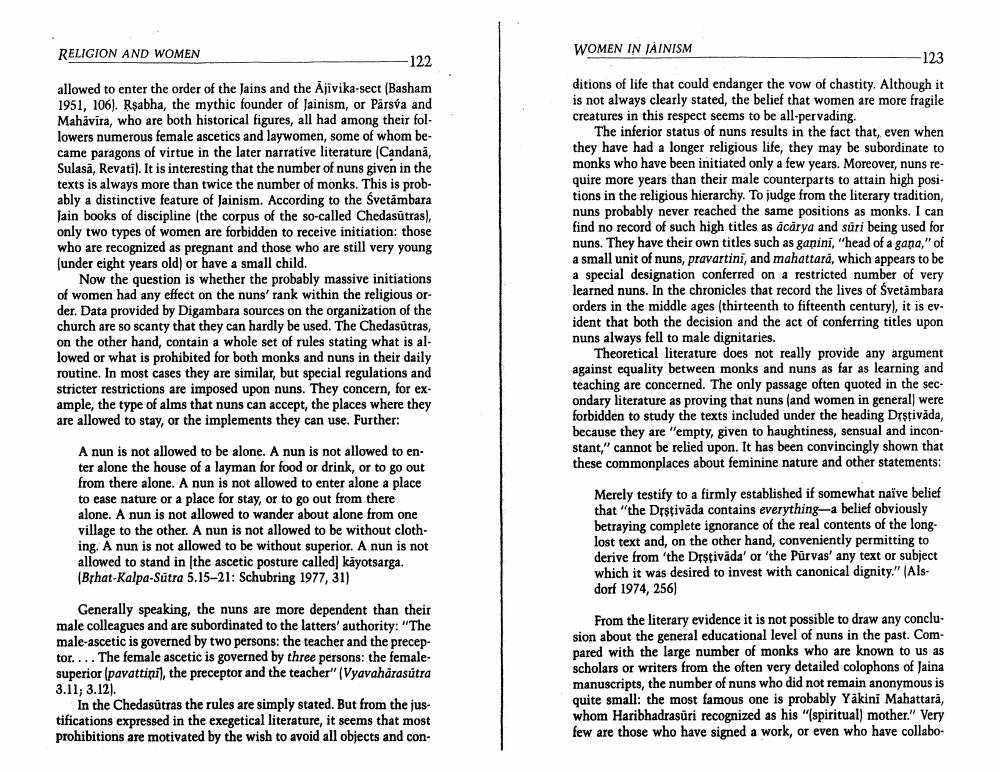Book Title: Women In Jainism Author(s): Nalini Balbir Publisher: Nalini Balbir View full book textPage 2
________________ RELIGION AND WOMEN -122 allowed to enter the order of the Jains and the Ajivika-sect (Basham 1951, 106). Rşabha, the mythic founder of Jainism, or Pärsya and Mahavira, who are both historical figures, all had among their fol. lowers numerous female ascetics and laywomen, some of whom became paragons of virtue in the later narrative literature (Candana, Sulasă, Revati). It is interesting that the number of nuns given in the texts is always more than twice the number of monks. This is probably a distinctive feature of Jainism. According to the Svetambara Jain books of discipline (the corpus of the so-called Chedasūtras), only two types of women are forbidden to receive initiation: those who are recognized as pregnant and those who are still very young (under eight years old) or have a small child. Now the question is whether the probably massive initiations of women had any effect on the nuns' rank within the religious or der. Data provided by Digambara sources on the organization of the church are so scanty that they can hardly be used. The Chedasútras, on the other hand, contain a whole set of rules stating what is allowed or what is prohibited for both monks and nuns in their daily routine. In most cases they are similar, but special regulations and stricter restrictions are imposed upon nuns. They concern, for example, the type of alms that nuns can accept, the places where they are allowed to stay, or the implements they can use. Further: WOMEN IN JAINISM 123 ditions of life that could endanger the vow of chastity. Although it is not always clearly stated, the belief that women are more fragile creatures in this respect seems to be all-pervading. The inferior status of nuns results in the fact that, even when they have had a longer religious life, they may be subordinate to monks who have been initiated only a few years. Moreover, nuns require more years than their male counterparts to attain high positions in the religious hierarchy. To judge from the literary traditi nuns probably never reached the same positions as monks. I can find no record of such high titles as acārya and suri being used for nuns. They have their own titles such as ganini, "head of a gana," of a small unit of nuns, pravartini, and mahattara, which appears to be a special designation conferred on a restricted number of very learned nuns. In the chronicles that record the lives of Svetämbara orders in the middle ages (thirteenth to fifteenth century), it is ev. ident that both the decision and the act of conferring titles upon nuns always fell to male dignitaries. Theoretical literature does not really provide any argument against equality between monks and nuns as far as learning and teaching are concerned. The only passage often quoted in the secondary literature as proving that nuns and women in general) were forbidden to study the texts included under the heading Destivāda, because they are "empty, given to haughtiness, sensual and incon stant," cannot be relied upon. It has been convincingly shown that these commonplaces about feminine nature and other statements: A nun is not allowed to be alone. A nun is not allowed to enter alone the house of a layman for food or drink, or to go out from there alone. A nun is not allowed to enter alone a place to ease nature or a place for stay, or to go out from there alone. A nun is not allowed to wander about alone from one village to the other. A nun is not allowed to be without clothing. A nun is not allowed to be without superior. A nun is not allowed to stand in the ascetic posture called) kayotsarga. (Bphat-Kalpa-Sūtra 5.15-21: Schubring 1977, 31) Merely testify to a firmly established if somewhat naïve belief that "the Destivada contains everything-a belief obviously betraying complete ignorance of the real contents of the longlost text and, on the other hand, conveniently permitting to derive from the Drşțivada' or 'the Pūrvas' any text or subject which it was desired to invest with canonical dignity." (Alsdorf 1974, 256) Generally speaking, the nuns are more dependent than their male colleagues and are subordinated to the latters' authority: "The male-ascetic is governed by two persons: the teacher and the preceptor. ... The female ascetic is governed by three persons: the femalesuperior (pavattini), the preceptor and the teacher" (Vyavaharasūtra 3.11; 3.12). In the Chedasūtras the rules are simply stated. But from the justifications expressed in the exegetical literature, it seems that most prohibitions are motivated by the wish to avoid all objects and con From the literary evidence it is not possible to draw any conclu. sion about the general educational level of nuns in the past. Compared with the large number of monks who are known to us as scholars or writers from the often very detailed colophons of Jaina manuscripts, the number of nuns who did not remain anonymous is quite small: the most famous one is probably Yåkini Mahattara, whom Haribhadrasuri recognized as his "spiritual) mother." Very few are those who have signed a work, or even who have collaboPage Navigation
1 2 3 4 5 6 7 8 9 10 11 12
